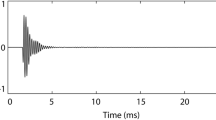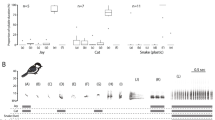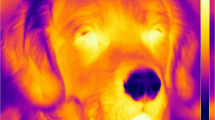Abstract
How organisms (including people) recognize distant objects is a fundamental question1. The correspondence between object characteristics (distal stimuli), like visual shape, and sensory characteristics (proximal stimuli), like retinal projection, is ambiguous. The view that sensory systems are ‘designed’ to ‘pick up’ ecologically useful information is vague about how such mechanisms might work2. In echolocating dolphins, which are studied as models for object recognition sonar systems, the correspondence between echo characteristics and object characteristics is less clear3. Many cognitive scientists assume that object characteristics are extracted from proximal stimuli, but evidence for this remains ambiguous. For example, a dolphin may store ‘sound templates’ in its brain and identify whole objects by listening for a particular sound. Alternatively, a dolphin's brain may contain algorithms, derived through natural endowments or experience or both, which allow it to identify object characteristics based on sounds. The standard method used to address this question in many species4,5,6,7 is indirect and has led to equivocal results with dolphins8,9,10. Here we outline an appropriate method and test it to show that dolphins extract object characteristics directly from echoes.
This is a preview of subscription content, access via your institution
Access options
Subscribe to this journal
Receive 51 print issues and online access
$199.00 per year
only $3.90 per issue
Buy this article
- Purchase on Springer Link
- Instant access to full article PDF
Prices may be subject to local taxes which are calculated during checkout

Similar content being viewed by others
References
Goldstein, E. B. (ed.) Blackwell Handbook of Perception (Blackwell, Oxford, 2001)
Gibson, J. J. The Ecological Approach to Visual Perception (Houghton Mifflin, Boston, 1979)
Au, W. W. L. The Sonar of Dolphins (Springer, New York, 1993)
Garbin, C. P. Visual-haptic perceptual nonequivalence of shape information and its impact upon cross-modal performance. J. Exp. Psychol. Hum. Percept. Perform. 14, 547–553 (1988)
Davenport, R. K. in Origins and Evolution of Language and Speech (eds Harnad, S. R., Steklis, H. D. & Lancaster, J.). Ann. NY Acad. Sci. 280, 143–149 (1976).
Gunderson, V. M., Rose, S. A. & Grant-Webster, K. S. Cross-modal transfer in high- and low-risk infant pigtailed macaque monkeys. Dev. Psychol. 26, 576–581 (1990)
Weiskrantz, L. & Cowey, A. Cross-modal matching in the rhesus monkey using a single pair of stimuli. Neuropsychology 13, 257–261 (1975)
Harley, H. E., Roitblat, H. L. & Nachtigall, P. E. Object representation in the bottlenose dolphin (Tursiops truncatus): Integration of visual and echoic information. J. Exp. Psychol. Anim. Behav. Process. 22, 164–174 (1996)
Pack, A. A. & Herman, L. M. Sensory integration in the bottlenosed dolphin: Immediate recognition of complex shapes across the senses of echolocation and vision. J. Acoust. Soc. Am. 98, 722–733 (1995)
Herman, L. M., Pack, A. A. & Hoffman-Kuhnt, M. Seeing through sound: Dolphins (Tursiops truncatus) perceive the spatial structure of objects through echolocation. J. Comp. Psychol. 112, 292–305 (1998)
Evans, W. E. Echolocation by marine delphinids and one species of fresh-water dolphin. J. Acoust. Soc. Am. 54, 191–199 (1973)
Au, W. W. L., Schusterman, R. J. & Kersting, D. A. in Animal Sonar Systems (eds Busnel, R. G. & Fish, J. F.) 859–862 (Plenum Press, New York, 1980)
Nachtigall, P. E., Murchison, A. E. & Au, W. W. L. in Animal Sonar Systems (eds Busnel, R. G. & Fish, J. F.) 945–947 (Plenum Press, New York, 1980)
Roitblat, H. L., Penner, R. H. & Nachtigall, P. E. Matching-to-sample by an echolocating dolphin. J. Exp. Psychol. Anim. Behav. Process. 16, 85–95 (1990)
Xitco, M. J. Jr & Roitblat, H. L. Object recognition through eavesdropping: Passive echolocation in bottlenose dolphins. Anim. Learn. Behav. 24, 355–365 (1996)
Au, W. W. L. & Pawloski, D. A. Cylinder wall thickness discrimination by an echolocating dolphin. J. Comp. Physiol. A 172, 41–47 (1992)
Acknowledgements
This work was supported by Walt Disney Company's Animal Programs, New College of Florida and the University of South Florida. All experimental procedures were evaluated and approved according to animal welfare regulations specified under National Institutes of Health guidelines. We thank: G. Bauer, J. Gory, A. Stamper, W. Fellner and J. Orth for discussion and manuscript review; D. Clark, D. Bickel, W. Fellner and K. Yannessa for research session and data management; J. Davis, A. Stamper, T. Hopkins, B. Stevens, J. Ogden and J. Mellen for administrative support; and M. Muraco, M. Barringer, B. Cavanaugh, L. Davis, D. Feuerbach, C. Goonen, L. Larsen-Plott, K. Odell and C. Litz for training the dolphin.
Author information
Authors and Affiliations
Corresponding author
Ethics declarations
Competing interests
The authors declare that they have no competing financial interests.
Supplementary information
41586_2003_BFnature01846_MOESM1_ESM.jpg
Supplementary Figure SI1: Figures SI1 – SI6. Fifty-four “junk” objects were presented in six groups that each contained three 3-object problems. In Groups 1, 3, and 5, the sample was presented echoically and the alternatives, visually. In Groups 2, 4, and 6, the sample was presented visually and the alternatives, echoically. Boxed objects were arbitrarily paired. (JPG 49 kb)
Rights and permissions
About this article
Cite this article
Harley, H., Putman, E. & Roitblat, H. Bottlenose dolphins perceive object features through echolocation. Nature 424, 667–669 (2003). https://doi.org/10.1038/nature01846
Received:
Accepted:
Issue Date:
DOI: https://doi.org/10.1038/nature01846
This article is cited by
-
Target-oriented Passive Localization Techniques Inspired by Terrestrial Arthropods: A Review
Journal of Bionic Engineering (2022)
-
Equivalence classification, learning by exclusion, and long-term memory in pinnipeds: cognitive mechanisms demonstrated through research with subjects under human care and in the field
Animal Cognition (2022)
-
Understanding across the senses: cross-modal studies of cognition in cetaceans
Animal Cognition (2022)
-
Information-seeking across auditory scenes by an echolocating dolphin
Animal Cognition (2022)
-
Long-Term Monitoring of Dolphin Biosonar Activity in Deep Pelagic Waters of the Mediterranean Sea
Scientific Reports (2017)
Comments
By submitting a comment you agree to abide by our Terms and Community Guidelines. If you find something abusive or that does not comply with our terms or guidelines please flag it as inappropriate.



